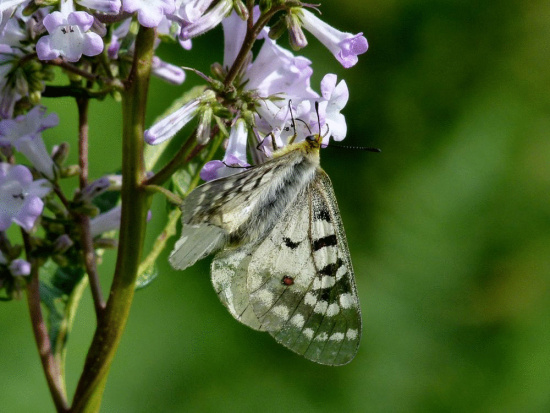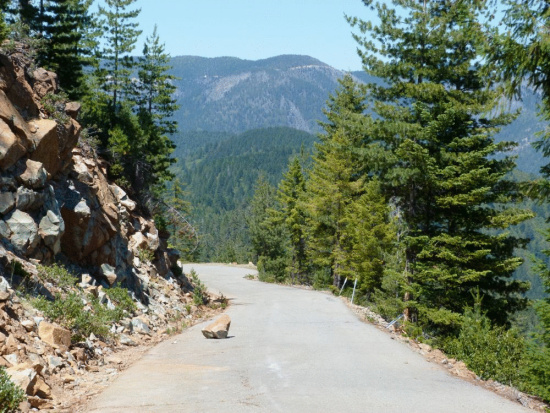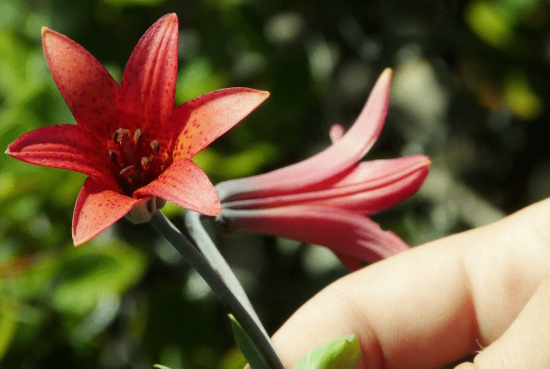Mealtime: A Clodious Parnassian on Yerba Santa (Eriodictyon californicum) By Tony Kurz.
This story is dedicated to my dad, Henry, who fostered my love for the natural world, and who never left me out of a weekend road trip. Happy Father’s Day.
# # #
To get a taste of some of the unique natural beauty the North Coast has to offer, you need not always go too far from the closest roadside. Sometimes all it takes is keen observation, a moment’s quick thought to pull over, and the desire to seek it out. June 13th is a warm and sunny Saturday for an all-day outside adventure as my boyfriend Tony and I head north from Arcata towards Hiouchi in Del Norte County.
Our goal: to explore as much of the Smith River National Recreation Area and Siskiyou Wilderness as we possibly can in one day. While that might seem daunting, what makes our ambitious plan possible are two paved arteries off State Route 199: the Gasquet-Orleans (“GO”) Road and South Fork Road. These two thoroughfares open up miles of rugged wilderness to visitors with a variety of experience levels and time constraints, and we are definitely on a time constraint.
Before we can arrive at our starting spot, our adventure begins early. Just a few miles south of Crescent City, our attention is captured by flashes of orange and pink on the banks of Highway 101 near the Mill Creek Campground. The culprits: Oregon Lilies (Lilium columbianum) and Red Clintonia (Clintonia andrewsiana), which are in the peak of their blooming season this time of year. These native species of lilies thrive in the shady and moist environment provided by coastal conifer forests, in this case where Highway 101 has bisected. We pause to snap photos of the lilies bending in the wake of oncoming traffic before continuing on our way.
About seven miles northeast on the 199 is the right-hand turn for South Fork Road. Several miles down, after pulling over to explore a roadside Darlingtonia seep, a dash of red catches my eye as we start to drive away. “Stop the car babe!” I say excitedly. “Back up for a second.” Drenched in sweat and sunscreen, I kneel down to examine the showy flowers of Crimson Columbine (Aquilegia formosa). Heading back toward the car (and air conditioning), I cross paths with an incredible find silently fluttering in the midday sun. It’s a Great Arctic (Oeneis nevadensis), an uncommon butterfly with an unusual life cycle. According to our field guide, this butterfly only flies within its range biennially; it takes two years for its larva to metamorphose into mature adults. If we were to come back to this very same roadside pullout next year, it would be as if they never even existed.
Heading southeast we’re about seven miles on the “GO” Road when we turn right and follow the signs toward Red Mountain Lookout Tower. Eventually, the pavement gives way to gravel as we keep right on the Forest Service road into high-elevation habitat. Several miles up, we pull off to appreciate the miles of view. To the northwest lies the mouth of the Klamath, hazy with the late midday sun, while behind us to the east, the last snow is still discernible on the higher summits of the Trinity Alps. Suddenly, I notice some unusual flowers growing out of the manzanita shrub to my right and dash off to investigate. It’s another lily, this time a rare Bolander’s Lily (Lilium bolanderi). The Bolander’s Lily’s range is restricted to a small portion of Southern Oregon and Northern California, where it has adapted to life growing on the unique serpentine soil (I’ll discuss serpentine in my next ramble). We look around to see if there are any more clusters of Bolander’s Lilies in sight: nothing. Of all the places to stop and look at the view, we happen to encounter the only Bolander’s Lilies for miles. Incredible luck!
The sunlight is slowly waning when we turn back on “GO” Road. There’s just enough time to squeeze in a small hike, so we’re off again, this time toward the trailhead where the road abruptly ends in the wilderness. We notice a patch of Yerba Santa (Eriodictyon californicum) growing on an embankment. Pulling over, we are surrounded by swarms of pollinators grabbing a last meal before night settles in. Amid the hums of dozens of bees we spot various species of butterfly. There’s the easily recognizable Anise and Pale Swallowtails, an impressive Monarch, an inconspicuous Duskywing, and several species of Blues. Tony’s attention is focused on the Clodious Parnassians (Parnassius clodius), in hopes that one of these cream-colored gossamer fliers might actually turn out be a Rocky Mountain Parnassian (Parnassius smithenus), a close relative whose normal territory ranges from Colorado north to the southern edge of the Yukon Territory. “Nope,” he says. “No Rocky Mountain Parnassians here.” The amount of activity surrounding us makes it hard to want to get back in the car and continue on, but curiosity and the ever-decreasing daylight drive us onward to our destination.
A late evening plunge into the Smith River is the perfect remedy when you’re exhausted and partially dehydrated (Rule 1: always bring more water than you think you need!) from more than seven hours of exploration. A newly-hatched Pacific Clubtail dragonfly (Gomphus kurilis) shares the small sandy riverbank where we’ve left our shoes and looks in much better condition than we are. No cars cross the bridge on South Fork Road as we swim quietly below. The day is over, and we eagerly head back toward civilization for water and Chapstick (Rule 2: never forget Chapstick).
It amazes me how much we’ve seen here simply by taking a moment to explore the roadsides around us. What may seem like the border between cement and dirt actually holds far greater perspective: you simply have to discover it for yourself. James Carse, professor emeritus of history and literature of religion at New York University, said it best: “Genuine travel has no destination. Travelers do not go somewhere, but constantly discover they are somewhere else.” I could not agree more.




CLICK TO MANAGE